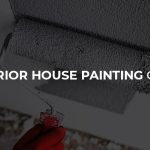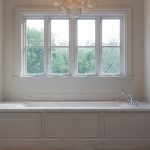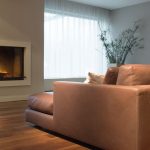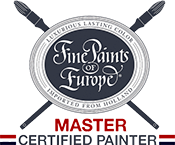Flooring & Wall Color Combination Guide
May 15, 2024
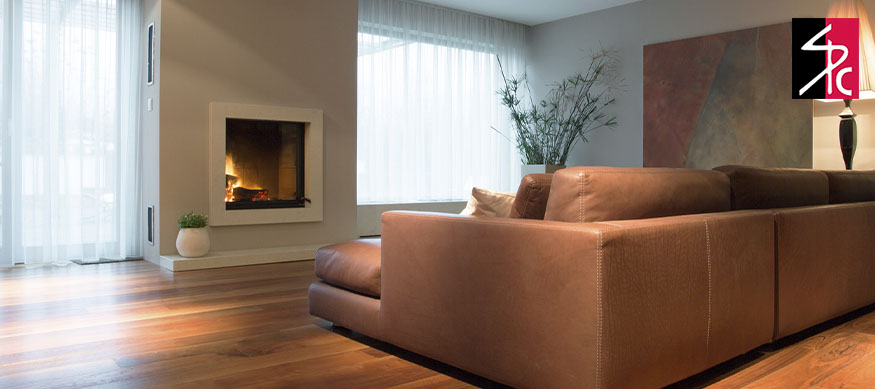
Hardwood and tile floors offer convenience, durability and versatility, suiting styles from classic to modern. When you choose these flooring options, you gain warmth and texture throughout your home, whether you use it in your living room, dining room or bedrooms. To highlight your floors and bring out their beauty, your wall colors should complement the natural tones and shades.
Entrust experts from Shoreline Painting to choose the perfect colors for your home painting project. We can direct you to gorgeous paint colors that go with various flooring styles to enhance your home’s aesthetic. Discover tips on the best floor and wall color combinations for your rooms below.
Factors for Choosing Paint Colors
Many factors come into play when studying your flooring in an effort to find the perfect paint for your walls or cabinets. Our experts understand how specific flooring and room characteristics must be taken into consideration to choose the best paint colors for a room you’ll be proud to show off. Learn about some of the important details we keep an eye out for when we begin the process of finding complementary paint colors.
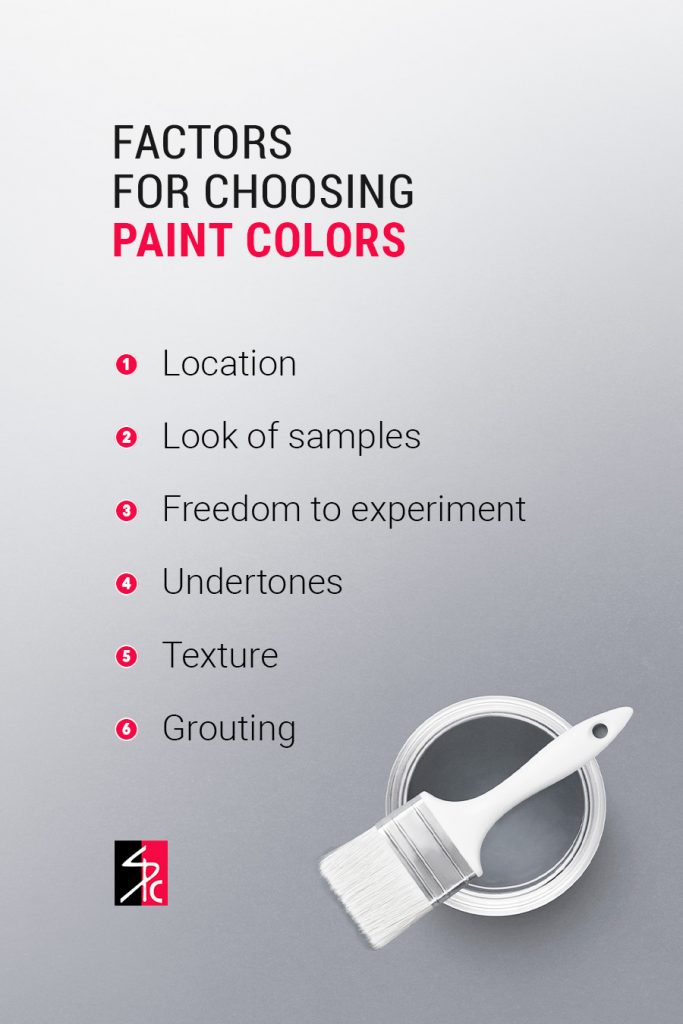
1. Location
Think about the space where we will add the new color. For bathroom wall paint colors, it’s important to take fixtures into consideration in addition to the flooring, such as the toilet, sink and cabinet hardware. What kind of ambiance would you like the room to have? For example, beige tiles paired with soft blues or greens can make a bathroom feel fresh and relaxing, while darker colors provide sophistication and drama when paired with all-white fixtures.
2. Samples
Tile and hardwood floor samples are handy when comparing potential paint colors. Samples save a lot of time and energy because you can immediately determine whether the colors make sense compared to your flooring options or if they are way off the mark.
Utilizing paint samples to compare with the floor samples in the to-be-painted room is a crucial evaluation step due to differences in lighting. While a color may look nice by itself, it could appear completely different under the lighting of the room awaiting a fresh coat of paint.
3. Experiment
There is no written rule saying that kitchen paint colors have to be a certain way. That is one of the best parts about selecting paint colors. You have the freedom to express yourself inside your home, and a luxurious paint treatment is a beautiful reflection of your personality and tastes.
Adding pops of color can help flooring stand out in the best way possible and make a space much more visually appealing. Don’t be afraid to consider colors that you may not have thought of before and see how they match up to your floor — that’s why we’re here to walk you through the paint selection process. You may be surprised at what you find.
4. Undertones
Determining the undertones of your hardwood or tile flooring is an important part of the wall color selection process. Tiles that have cool undertones look best with blue or green tones, and we take caution to avoid yellow undertones, as they will clash.
Flooring that has warm undertones looks best with soft neutrals and hues with yellow tones. We may advise you to avoid colors that read as too tan because they can make a room feel drab and dreary instead of warm and inviting.
5. Texture
Textured flooring look better with some colors, while other non-textured tiles may not. For example, floor tiles made of natural stone tend to look their best when paired with neutral colors or those that will bring out the natural tones of the stone, such as pairing blues or greens with slate. Beige or white tiles with a sleek, high-gloss finish look fantastic against darker, more dramatic backdrops.
6. Grouting for Tile Flooring
Some people tend to focus so much on the flooring that they forget about an important component: the grout. Grouting should not be ignored when it comes to finding the best wall and tile floor color combinations.
Depending on the space and other factors, sometimes the best approach is less about the tile color and more about finding a wall color that matches or complements the grout. This paint selection strategy is particularly helpful if your space has more than one kind of tile but the same kind of grout throughout.
How to Match Wall Paint Color With Your Wood Floor
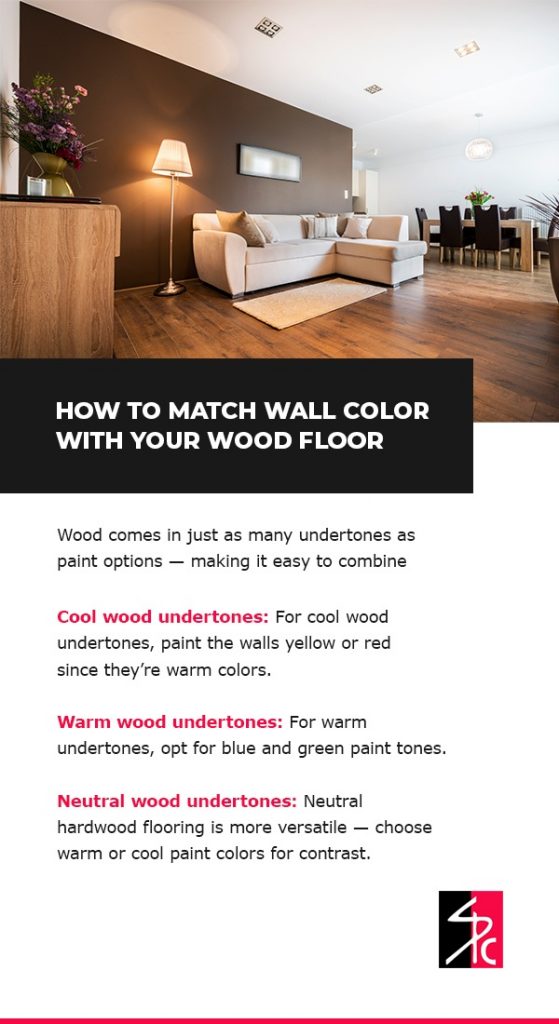
Your hardwood floor and wall colors reflect the style you wish to convey, so you’ll want to choose the best combinations. At Shoreline Painting, we understand the secret to choosing the right paint colors to complement wood floors, and it all comes down to undertone color contrasts. In other words, it’s essential to pair your wood flooring’s undertones with the opposite side of the temperature spectrum is essential. If you have yet to install hardwood, choose the best contrasting wood undertone to complement your wall colors.
Wood comes in just as many undertones as paint options — making it easy to combine your colors and create an inviting space:
- Cool wood undertones: Cool wood undertones include green, blue and pink. For cool wood undertones, paint the walls yellow or red since they’re warm colors. Choose your wall shades carefully to avoid blue or green, cool colors.
- Warm wood undertones: Warm wood undertones include red, yellow and orange. For warm undertones, opt for blue and green paint tones. You’ll likely want to avoid too much tan and cream because it won’t do anything to bring out your floor’s undertones and could appear too warm.
- Neutral wood undertones: Neutral wood undertones include gray, beige and taupe. Neutral hardwood flooring is more versatile, so you have more freedom to choose warm or cool paint colors for contrast.
By choosing contrasting colors, rooms feel more balanced and comfortable. Stray from choosing paints with similar undertones as your wood floors since they can make your space look too cohesive. If you’d like your colors to be equal, choose subtle wall color shades that are easy on the eye. With the right color combination, your home will be the perfect oasis for comfort and style.
How Do You Determine Wood Color Undertones?
To determine your hardwood’s undertones, place a few pieces of it together to get an idea of what the wood will look like once it’s installed. Is it warm and golden? Cool, gray or ashy? The answer will help you decide on your wall color. The flooring manufacturer may offer details on your flooring’s undertones if you purchased new flooring.
When you need extra help, consult with Shoreline Painting — we can help you decide on the perfect colors for your rooms without you needing to lift a finger.
Paint Color Combinations for Light Wood Floors
Light hardwood floors are popular, especially with the growing farmhouse-style trend. If you have concerns about a dark-colored floor making your room appear too somber, you can keep the floor light in tone to make the atmosphere bright. There are also plenty of paint colors that go with light wood so you can craft the perfect look for your walls and space.
Contrast With a Saturated Tone
Your light hardwoods serve as the perfect companion to saturated, bold hues. For instance, light gray hardwoods would look stunning next to a burnt orange or coral wall.
Choose Brilliant Jewel Tones
Jewel tones are any color you would associate with precious gemstones, such as sapphire, emerald, amethyst and ruby:
- Blue: A crisp dark blue would contrast nicely against your light hardwoods, and both design elements would pop next to one another. Blues and their gentle undertones always usher in a soothing, calm feeling, while a bold sapphire adds personality.
- Green: Green is the contrasting color to red, so emerald is the natural choice to complement light flooring that has warm undertones. Or pair emerald with a neutral white hardwood to create an ideal balance between light and dark.
- Plum: Plum is another excellent color that pairs well with gray- and beige-colored hardwood. And since purples can have red undertones, plum paints will add warmth to your space.
- Red: If your hardwood has cool or neutral undertones, you can warm up your home with a rich ruby wall color. You can also err on the cooler side with an on-trend, deep-berry paint shade.
Stay Safe With Neutral Tones
If saturated or jewel tones are too bold for your home, you can always complement your light hardwood floors with a neutral wall. Be sure to select a neutral tone that matches the hue of your floor. For instance:
- Beige: For light hardwood floors with cooler tones like gray, go with beige. Beige tones create a warm, inviting environment, and they also keep the room balanced if you have colorful decor or furniture.
- Soft black: You may put your defenses up when you think of a black wall, but a soft black creates an exciting contrast against light hardwood flooring, giving your room a modern touch.
- Gray: If your floors have warmer, yellow undertones, you can’t go wrong with gray walls. Choose a gray with blue-green hues to give your room an earthy style and stand out from the warm tones of your light hardwood flooring.
How to Choose Wall Color Combinations for Cherry Hardwood
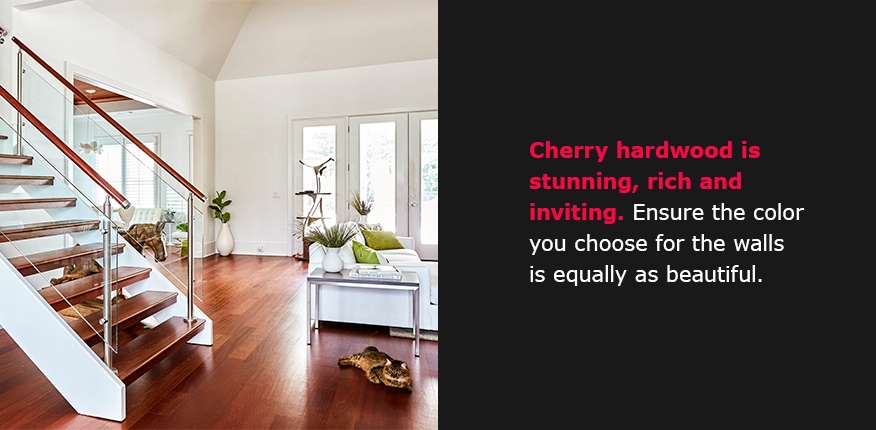
Cherry hardwood is stunning, rich and inviting. Ensure the color you choose for the walls is equally as beautiful. Several paint colors go with cherry wood, whether it’s on your trim or just your floors.
Go Green for a Beautiful Contrast
Many green tones would look attractive in a room with cherry hardwood, such as:
- Sage: In sage’s case, its softness lets the cherry hardwood shine and be the focal point of your room. Soft green colors have been on trend for their calming effects that suit modern and classic styles.
- Forest: You could try a darker green if you prefer a more vibrant but less contrasting look, such as forest. The cool, almost gray color plays well with cherry wood’s bold, rich hue.
Be careful when selecting your paint color — you do not want to venture into green shades with a yellow undertone, such as olive, which can clash with the warmth of your cherry hardwood flooring.
Choose a Cool Blue Shade for a Peaceful Space
Blue is a popular color for walls in modern homes, and you can certainly pair it with a cherry hardwood floor. Examples include:
- Robin’s egg blue: Soft blue paint colors complement a cherry hardwood floor very well, creating a peaceful and inviting space. Light colors provide the perfect contrast for cherry, letting the red-hued planks stand out. Consider this combination for a bedroom, dining room or family room.
- Dark navy blue: A dark blue complements the dark colors in your cherry hardwood while providing just enough of a contrast.
- Cerulean blue: For a pop of color and personality, choose a rich cerulean blue. This color often features green undertones, letting it contrast nicely with cherry hardwood.
- Pale blue: A serene, light blue that borders on gray is a timeless option to complement cherry floors. Pale, almost neutral blues are especially ideal if your goal is to make your home a retreat where you and your family can unwind at the end of the day.
Keep It Simple With Neutral Colors
Each neutral color has a multitude of tones and shades. Here are some neutral colors and their variations:
- Whites: Of course, you can go for a classic pure white paint that provides a canvas for any style or theme you have in your home. You could also soften the room by choosing cream or eggshell white. White walls and trims are versatile, allowing you to get creative with your art and other decor.
- Grays: Although white is a safe choice, gray can make any room look slightly more modern. If you’re going for a sleek, modern look in your home with cherry hardwood flooring, go for gray walls. There are many variations of gray, so you can select one that makes your furniture and decor stand out.
- Browns: We can’t exclude brown from the list when pairing neutral colors with cherry wood floors. Brown offers many options, including beige, mocha brown and cool brown. One thing to keep in mind when considering brown is to steer away from warm browns, like chestnut or sienna, since they are too similar to cherry.
Color Combinations to Consider With Dark Hardwood Floors
Dark hardwood floors are popular because they don’t show every speck of dirt, and they have a premium, classic look, which many people appreciate. Dark hardwood floors are an excellent choice if you want to decorate a large room or if your home has an open floor plan. Once dark flooring is installed, it can make a space look smaller and cozier.
Before installing dark hardwood in your home, consider the light sources in the space. Does the room or area get plenty of natural light? If not, do you have overhead lights in place? If there is not a lot of natural light, ensure sufficient lighting in the space from overhead lights and lamps — otherwise, the dark hardwood will appear too dark.
Below are a few tips for choosing the best paint colors for dark floors.
Look at the Undertones in the Stain
When selecting wall paint colors for dark wood floors, you will want to consider the undertones in the stain used to finish the floor. If your floor is black or almost black — with neutral undertones — you have an exquisite foundation from which to work when picking out your wall paint color.
Keep It Light and Neutral
Keep your walls and trim light and neutral in tone. You’ll want your wall and trim to be the same color for maximum effect. For your trim, choose a semi-gloss or a high-gloss finish so that it will stand up to the punishment that occurs in corners and areas near door jams.
Paint It Off-White
White looks clean and neat on painted walls. If stark white looks too clinical for your taste, tone it down slightly with an off-white shade. These colors are softer than plain white, but they still work very well with the light hardwoods to keep the room’s entire look clean and bright.
To take the off-white look further, choose pale peach. It’s a rising trend that offers a cozy, warm feel ideal for living spaces and bedrooms. This warm color contrasts well with cool or neutral wood undertones.
Go With Gray
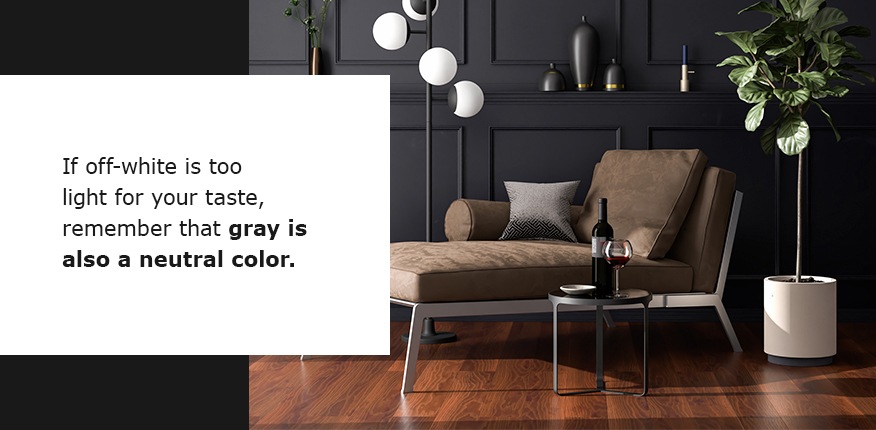
If off-white is too light for your taste, remember that gray is also a neutral color. Choose the exact shade for your room carefully while considering whether you want a gray with undertones or without. Popular gray paint undertones include:
- Blue
- Pink
- Mauve
- Green
- Yellow
To determine a gray’s undertone, compare it to the back of a color chip. When you look at the shade against something white, you can see the undertone more clearly than if you look at the color itself.
Different undertone shades will bring out a completely different vibe — a cooler gray with blue or green influences creates a relaxing atmosphere. Warm, yellow undertones alongside dark hardwood floors make an open and inviting space, perfect for living rooms or kitchens.
Choose Cool Blues and Greens
If you prefer more color on the walls, you have many options. Black is neutral, so you can pair virtually any color with it. Consider cool blues and greens for wall colors, being mindful of the size of the space. A dark shade on the wall with a dark floor tends to close in the room.
Branch out Into Greige
It’s a little bit of gray and a little bit of beige, which works exceptionally well alongside your dark hardwood floors. If you’re looking to select a wall color you can paint in every room where you lay your new flooring, you might want to put greige on the shortlist. It creates the perfect backdrop for a slew of different styles, and having a single color in every room will tie everything together perfectly.
The Best Wall Color Combinations for Oak Floors
Oak hardwood floors are a beautiful choice in flooring, and they give you several options when it comes to wall colors. We always consider whether you have white or red oak before selecting a paint color for your project.
Wall Colors for Red Oak Floors
When you’re searching for the perfect color to pair well with red oak floors, choose dark, cool blue and green tones to enhance the warm tones of red oak flooring. Consider colors and shades such as:
- Aquamarines
- Dark blues
- Dark greens
- Pastel green and blue
Wall Colors for White Oak Floors
White oak flooring can look bleached and rustic, depending on its finish. It provides a simple backdrop for wall colors and allows us to create a refined, classic and beautiful space. For instance, a rich charcoal to match the wall color to the wood creates a luxurious and formal look for an elegant dining room.
Choose your favorite shade to give the room some interest and make sure the walls aren’t too light, which can whitewash the room.
Earthy Colors Work for Both White Oak and Red Oak
Many people select oak for its rich, all-natural color. You can complement the rustic feel of any variety of oak with an equally earthy paint color. Consider light and earthy hues to enhance the natural look of your oak. Everything from a gray to a lush green would bring out the grains and gorgeousness in your oak planks.
Rich and light colors that complement the richness of oak in any shade include:
- Navy
- Cinnamon
- Plum
- Forest green
The light-colored flooring will help to keep the space from looking too dark, while the exciting cool colors create a beautiful contrast to your natural oak.
How to Match Wall Paint Color With Your Tile Floor
Choosing the right color palette to complement tile flooring can be tricky. Wall and floor combinations are actually one of the most debated factors of home design. That is because the color you choose can either make or break the entire feel of a room. You may be tempted to choose the first color that you find visually appealing. However, selecting the best wall colors to match decorative tile floors takes a little bit more time and consideration. It should also not be the first step you take when giving your home an interior makeover.
While it’s a good idea to consider interior color trends, just because a hue is popular doesn’t mean it’s automatically a good fit for your room. Since there are many wall paint color and floor tile combinations, it can seem like a daunting task to ensure you select the right one. Fortunately, the professional color consultants at Shoreline Painting have tried-and-true guidelines to navigate this process, so you’ll feel confident in your final paint decisions.
Best Wall Colors for Light Tile Floors
Light floor tiles can be set off beautifully depending on the surrounding colors. Some feel that light tiles look their best when complemented with light walls, as it helps to give the illusion of the space being bigger than it really is. White walls look stunning and elegant against light-colored floors, and off-white and cream colors are also favorable.
Rooms with deep colors wrapping around light-colored tile flooring tend to feel smaller and cozier. Rich, dark tones also bring the feeling of drama thanks to the contrast between light and dark, which many people find visually appealing. Interested in a moody, sophisticated space? Pair a light gray tile floor with on-trend black walls for a high-contrast, timeless look.
For a happy medium between light and breezy and deep and moody, there are other options that can add a touch of color without going over the top. Light floor tiles often pair well with greys, beige, taupe and other neutrals. Dark brown and yellow walls should be avoided to prevent color clashing with your floors.
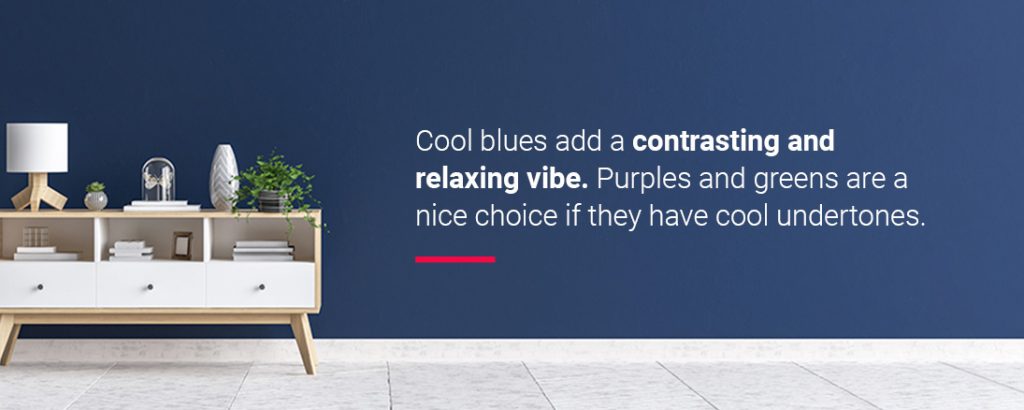
Gray Tile Floors Paint Color Options
Gray tile floors are becoming increasingly more common in homes of all styles. Selecting the right wall color can be a bit tricky depending on the undertones of your gray tiles.
For walls that will make your cool gray floor tiles stand out, our professionals may suggest a cool-toned color palette. Cool blues add a contrasting and relaxing vibe. Purples and greens are a nice choice if they have cool undertones. Keep it muted with lavender or a soft sage, or elevate the elegance with a deep eggplant or emerald hue. White paint can also make the gray floor tiles pop in their own unique, modern way while adding dimension.
If your gray tiles have a warmer undertone, using beige and brown tones on the walls amplifies the warmth. This combination will give off a cozy feeling, making it perfect for bedrooms or living rooms. Not afraid of bold hues? Make a statement with fiery reds, yellows or oranges.
It’s a good idea to avoid matching wall and floor tiles, as it can create a dimensionless vibe. While some people appreciate a monochromatic look, others may not feel as excited about the dreariness that it can have in a room. Professional color consultants can assist you with selecting the ideal wall color to make your gray floor tiles sing.
Perfect Paint Colors for Dark Tile Floors
Dark-colored floor tiles leave your space open to many wall color options. Using the right paint can elevate a room with feelings of chic sophistication. We have discovered that, when choosing a paint color surrounding a dark floor, it’s best to select a color at least three shades lighter than the flooring to help keep the walls and floors from running together.
That being said, if you desire a room with superior contrast, light and airy wall colors amp the contrast and break up the darkness of the flooring tiles. If your dark flooring has cool undertones, we can select complementary colors. If the dark tiles have warm undertones, keeping the wall colors warm creates a cohesive feeling in the space.
It’s always fun to experiment with matching or complementary colors. For instance, a yellow-undertone floor looks great with a purple-painted wall. Floors with red undertones look beautiful and rustic against variations of green. The sky is the limit when it comes to color options that work well with dark tile floors.
Best Wall Colors for Beige Tile Floors
Our professionals have found that one of the easiest ways to determine a compatible wall paint color based on your beige floor tile is to study the tiles and see if there are any other colors involved. Marbled or speckled floor tiles can often provide guidance. We can select a lovely color from those details and run with it.
One timeless neutral look is to match a beige floor with beige walls. While it may seem like this could turn out to be a dull route to take, selecting a beige that has a lighter or darker shade than the one on your floor can make a big difference. Also, white walls against a beige floor can make a bathroom or kitchen seem crisp and clean while helping the space feel exceptionally large.
For a burst of color, select red. Beige combined with deep red will provide a kitchen with rustic vibes, while brighter reds can offer a modern-glam feel. Natural red, such as the color of red brick, can add urban appeal without being too bold.
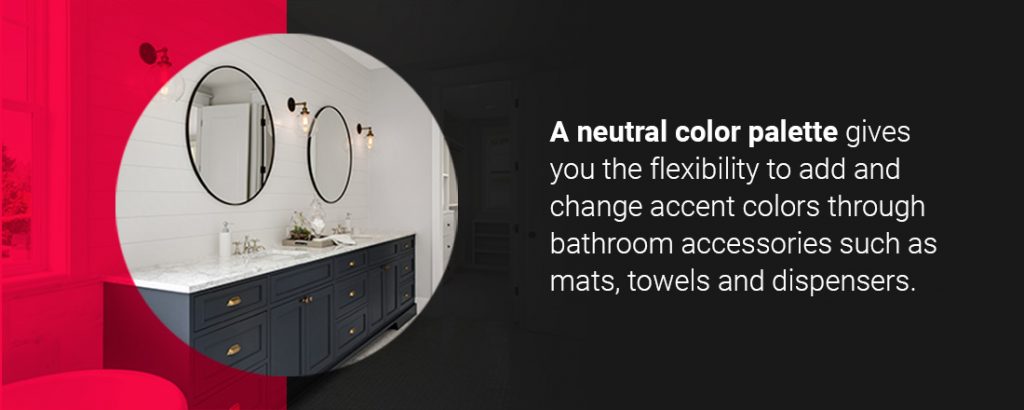
Selecting Bathroom Paint Colors
Choosing the right color palette for your bathroom can feel like a challenging task, especially when you are trying to work with the color of your floor tiles and the kind of lighting your bathroom has to offer. With our expertise, choosing the best bathroom colors becomes an enjoyable experience.
Neutral colors work well on bathroom walls, especially if your bathroom floor or fixtures are off-white. A neutral color palette gives you the flexibility to add and change different accent colors through bathroom accessories such as mats, towels, dispensers and more.
You may think that neutral means it has to be white or beige. However, there are many other colors to choose from that are still considered neutral. If creams and off-whites are not your preference, blues and grays may be more to your liking. Bold tones add a splash of color. Keep an eye on the undertones of your tile flooring. Paint with the same undertone as the tiles will help bring the entire room together.
Choosing Paint Colors for Kitchen Walls
Kitchens have come a long way over the decades in terms of color and style. That is why, no matter your floor tile, the color options for the walls are endless. Since a kitchen upgrade increases home value more than any other space in your house, it’s crucial to get the colors right for the best return on investment.
For a bold look, a coat of rich emerald green looks luscious against light flooring tiles. If you have dark flooring, you can brighten the kitchen with light blue colors. A beautiful shade of yellow envelops all who enter your kitchen with a feeling of happiness and calm. You can also never go wrong with an all-white kitchen, especially if you have sleek white floor tiling. And remember to view both your walls and cabinets as blank canvases — professionally refinished cabinets can transform the space’s entire look.
When it comes to the kitchen, balance is key — neutral colors with bright colors, dark against light, and warm undertones with cool undertones. This is why an expert evaluation of your flooring tiles is a valuable tool to select the best wall color and finish for your space.
Request a Consultation From Shoreline Painting
Are you thinking of painting your walls to complement new or existing flooring? Choose Shoreline Painting to help you transform your home! We are a family-owned business that’s been painting homes for over 35 years. You’ll want beautiful colors that match the durability and attractiveness of your hardwood or tile floor, and Shoreline Painting is excited to make your dream aesthetic a reality.
Shoreline Painting is a Fine Paints of Europe Master Certified Painter. We use only the highest quality paints and materials to make every part of your home look elegant and luxurious. We also provide exterior house painting to make your entire home shine and enhance your curb appeal.
If you live in either New York or Connecticut, request a free consultation today!
Recent Posts


